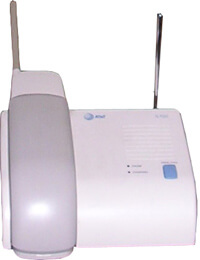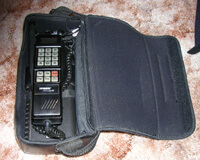How Cordless and Cell Phones Work: The Science Behind Untethered Telecommunications
How Cordless and Cell Phones Work: The Science Behind Untethered Telecommunications

An AT&T cordless phone (Telecommunications Virtual Museum file photo).
No More Cords!
For decades the telephone became more and more popular, until it became one of the center points of most everyone’s life. The telephone (and television) have become the standard way in which life is conducted, a focal point of everyone’s (and especially teenagers’) lives. And so, in an era of such high dependence, the seemingly minor annoyance of one’s phone having a cord, and thus a limit to its mobility around the house, became a grave and serious issue.
Well, not quite so grave as all that. But it was highly annoying. The person on the phone was, in effect, leashed to the wall, able to move only as far as the cord could reach—and, if you’ve ever had to find a pen and paper to write on to take a message, you’ve inevitably discovered said objects just out of reach, or perhaps gone entirely, and you’ve had to put the phone down and run around looking for said objects, and you’ve been frustrated and upset and (if the call was long distance, or if you pay by the minute for some other reason) monetarily put out.
And there were other dangers as well. Not only could the person taking the call end up tripping over the cord as they moved around with the phone, trying to find that pen and paper, but the next person along could trip over the cord, or it could snag on a piece of furniture and knock over that Ming dynasty vase you were about to sell, or all manner of Peter Sellers/Inspector Clouseau moments could be set in motion.
Enter a bright idea. Or, rather, re-enter an old bright idea, spruced up for the 1980s. The concept was really quite simple: The phone would be exactly the same as any phone in terms of receiving phone wires through the wall, but rather than connecting the outside line into the entire phone assembly, the line would be connected to a base. The base would then convert the electrical energy of the phone call (see How Phones Work for a further explanation of how a person’s voice was converted into electricity in the first place) into an FM radio wave, broadcast just like those from your local radio station, through the air. You would then have a handset, with parts just like a normal phone for talking and listening, but with an antenna to receive the radio wave broadcast by your base, and a converter to change the radio wave back into electricity and then back into an approximation of your friend’s voice. Talking into the handset worked the same way, but in reverse and using a second radio wave.
Now, converting the electrical current into radio waves was a very old idea; in fact, it had been used since the 1920s in long distance calls (see our article “Calling a Country Far, Far Away” for more); the conversion took place in the middle of the transmission, so that your call traveled down the wires to the radio transmitter, was converted to radio waves, sent over the ocean, and converted back into electricity. But for some reason no one had decided to use this technology closer to home, or rather in the home.
But don’t let that tarnish our Eureka! moment …
Eureka! Now you could be anywhere in the house, or maybe even your yard, and still be talking on the phone, and there was no tell-tale cord to trip people up or reveal your location. There were, however, just a few problems …
First, the first cordless phones operated at only one frequency with a small range of channels. This frequency was 27 MHz (megahertz), and it meant that these phones had a very limited range and generally poor sound quality. Walls and pipes interfered with the signal, and even flourescent lights could interfere with the signal.
Second, because of the limited number of channels on the 27MHz frequency, anyone with a radio scanner (or even another cordless phone) could listen in on your conversation. Security wasn’t even a thought with these phones.
Finally, even with the first two problems, cordless phones were exceedingly expensive. It took $400 to buy a decent phone—and that’s $400 in the early 1980s. Adjusted for inflation, that’s over $900 in 2005 money.
In 1986, the Federal Communications Commission (FCC), who decide which frequencies can be used for which purposes (and decide a host of other things, like what can be shown on television and how radio stations can operate), allowed the 47-49 MHz range to be used for cordless phones, which improved the interference problem (and made them easier to power as well). This did not, however, fix any of the security issues, and soon there were so many cordless phones using even this extended range of frequencies that the FCC granted more in 1994, using the 902-928 MHz range for cordless phones.
This in itself didn’t fix the security problem, although it did increase the range of the cordless phone. But converting to digital signals, which happened around the same time (1995), did help with security, because it allowed something called Digital Spread Spectrum (DSS) technology to be used.
DSS is not new, and wasn’t new in the mid-1990s, either. Spread spectrum technology has been around since World War II, when famous actress Hedy Lamarr co-invented it to help guide US torpedoes (see www.ieee.org for more). DSS uses a technique called frequency hopping—the transmitter sends signals not just on one frequency, but on many pseudo-randomly selected frequencies, hopping from one to the next using a code that only the transmitter and receiver know (a “pre-assigned spreading code,” to use the official language).
Frequency hopping has the added bonus of allowing the phone’s power to be increased, because it allows your phone to take advantage of the highest power (wattage) allowed by the FCC—one watt. This may not sound like much, but, as a comparison, those 47-49 MHz phones operated with .001 watt. Why are DSS phones allowed the full watt of power? Because they take up less space on the already-crowded airwaves. Their shift amongst hundreds of frequencies, each being used for only a fraction of a second, allows them to use so little power on each channel that other devices using the channel don’t even know your phone is there; at most, it would seem to be a kind of background noise, there and gone again, leaping from channel to channel before interfering or being interfered with, a balletic starship going in and out of warped space-time… Er… yes, well, that’s another story.

One of the old “brick” cell phones, before miniaturization struck (Telecommunications Virtual Museum file photo).
Cell Phones
Cell phones are similar to cordless phones in terms of combining radio technology and telephone technology; in fact, if you wanted to sum up cell phones with just one sentence, you’d say they operated just like cordless phones, but on a much grander scale. (OK, so you’d probably have to describe how cordless phones work as well, which would make it much longer than one sentence, but perhaps you could count on your audience having read our preceding section on cordless phones already.) A cell phone uses FM radio waves to broadcast a signal to an antenna tower (or base station) nearby (this would be analogous to the base of your cordless phone). The frequencies it uses are those assigned to your cell phone carrier for use in your city, and thus differ depending on whether you’re using MCI, Sprint, Qwest, etc. Your phone broadcasts its signal to the nearest antenna tower, which then re-broadcasts your signal to the central tower to be connected to land-based lines, or even directly to your friend on her cell phone on the other end.
In most cities, each tower’s reception area is about 10 square miles and is called a cell—which is why your phone is called a cell (or cellular) phone. As you travel about the city, you enter and leave different cells, and different towers take care of routing your call. And since your cell phone and antenna tower are transmitting using very low amounts of power (between .6 watts and 3 watts), towers that are two or more cells away from one another can use the same frequencies without interfering with one another. This frequency re-use allows many more people to use the network than would otherwise be able to, and it keeps the frequency spectrum clearer and more useful.
But I’m Moving!
One of the joys of cell phone use is that you can move around while talking on them—like with a cordless phone, except you can go just about anywhere civilization, or at least a cell tower, exists. But if a tower covers only ten square miles, and you move further than that during your call, how do you stay connected?
The simplest answer is that the various towers throughout a city know when you’re moving to the edge of one tower’s range and into the next tower’s range. How this happens is a bit more complicated and requires computer circuitry, central offices, and fun stuff like that.
Say you make a call from your car (on your hands-free set, so that you’re not violating any laws or endangering yourself and others trying to juggle a phone and drive at the same time … or let’s say you’re the passenger in the car, making your call … we have to be safety-minded, after all!). When you turn on your phone, it immediately tries to get in touch with the nearest base station, using what is known as a control channel (a frequency used by the phone and base station to communicate with each other, independent of you or your calls). If it can’t find an open control channel, it assumes it is out of range and displays a “No Service” message. If it does find a control channel, it listens for a System Identification Code (SID), which is a five-digit code assigned to all the various cell phone companies. If it finds a SID that matches its own SID (your phone, when you activate it with a given company, is given the company’s SID to store in its memory), it knows that it’s in its home territory (more on home and roaming in a bit).
Your phone also broadcasts information. Your carrier, besides using cell towers throughout the city, runs a Mobile Telephone Switching Office (MTSO), a central office . handling all of the phone connections to the land-based phone system and controlling all the carrier’s towers/base stations in the region. Your phone contacts the MTSO through the control channel and tells the office where you are, and can continually update this information so that the MTSO can keep track of you. This isn’t for any nefarious purpose, so that spy satellites can bathe you in lasers or trick you into seeing UFOs; it’s merely so the MTSO knows which cell to find you in when a call comes through for you.
All of the above happens behind-the-scenes; you just wait for your phone to finish finding its service, then dial the number you wish to call. Your phone broadcasts the phone number to the base station, which then forwards your request to the MTSO, and the MTSO picks a frequency pair that your phone uses in that cell to transmit and receive your call. (It tells your phone, and the tower, which frequencies to use by communicating through that control channel mentioned over and over again earlier.)
But now you’re moving out of your original tower’s range! What will happen?
Near the edge of the cell, the tower/base station senses your diminishing signal strength; simultaneously, the base station of the tower you’re moving toward senses that your signal strength is increasing. They both communicate this information to the MTSO, which keeps track of you and your signal strength and, at just the right moment, switches you from one base station to the next. If all goes well, you don’t even notice, and the MTSO is like a magician pulling a tablecloth out from under one set of dishes and replacing it with another. If all does not go well, the dishes fall to the floor with a crash of static, and your call is dropped.
Home and Away
If your phone’s SID doesn’t match the MTSO’s SID, then both know that you’re roaming (although you may not, if you don’t pay attention to the little indicators on your phone’s display). “Roaming” is a cute word the cell phone carriers use to mean that you’re out of your “home,” or lowest priced, area, and that now is the time to charge you more per minute for the privilege of expanded coverage.
In detail, the MTSO for the area you’re roaming in contacts your home MTSO and makes sure the SID for your phone is valid, then tracks your phone through the cells just like your home MTSO would. Then it reports back to your home MTSO so you can be billed appropriately.
Abra-ca-jargon
Believe it or not, the first cell phones operated on an analog system—that is, they used relatively uncompressed FM signals to communicate with the base stations and the MTSO. This worked fine as long as there weren’t many users, although the signal quality wasn’t always so great. Nowadays, however, cell phones (along with most everything else) have moved into the digital age.
Digital signals can be easily compressed and sent over the airwaves (and cables, and wires) much more efficiently than analog signals. This is somewhat analogous to sending a picture from your computer to your friend across the country: The analog way of doing this (printing the picture, then sending it through the post) works fine, but takes more effort (and space and time) than sending the picture electronically through email. And if you send your picture through the computer, you can choose various ways to “compress” the picture (making the file size smaller) and thus take up even less space and time sending it. (This is what those file extensions, like jpg and gif, are—various methods of compressing files.)
Digital isn’t automatically better, however, for with compression of files comes the possibility of reducing the image quality when it comes out the other end of the process. If you’ve worked with picture files, you’ve run across this: a jpg-format picture can be saved with varying levels of quality, and in general, the more compression, the less quality. Another analogy is cable or satellite television: When a channel is broadcast as a digital signal, the cable/satellite company decides how much compression to use before sending the channel’s signal out. More compression equals more space for more channels, but it also can result in a slightly jagged, rough-edged, “pixelated” look to the image when it arrives on your TV screen, making the digital signal look worse than the analog signal.
With cell phones, the same things apply. There are several different methods for compressing your signal, the most common being Code Division Multiple Access (CDMA) and Time Division Multiple Access (TDMA), more about which can be found at HowStuffWorks.com. With the right kind of network, these digitally compressed signals can be clearer and be more easily and quickly routed by the MTSOs, thus giving you a much better service than can be found with analog phones. And, with the wrong kind of network (one overzealous about bandwidth at the expense of quality), you can get echoes, breaks in your signal, and “pixelization” of your voice.
Why Call When You Can Play?
The future of cell phones is, indeed, now, as they move into providing more and more services all within the tiny confines of smaller and smaller handsets. You can buy phones that also act as internet connections, giving you wireless access to the Web on a tiny, but full color, screen. Most new cell phones also offer you text messaging, which is like being able to instant message your friends, but on the phone rather than a computer. And, really, the distinction between your cell phone and a laptop computer is diminishing by the day, as companies offer spreadsheets, word processors, and video games all through the telephonic interface. And who knows where it will go from there.


